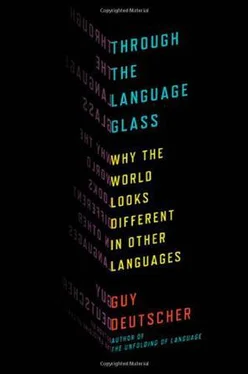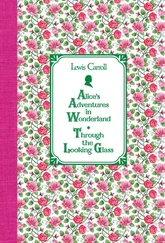– -. 1881. Farben und Schöpfung . Acht Vorlesungen über die Beziehungen der Farben zum Menschen und zur Natur. Breslau: Kern’s Verlag.
– -. 1883. Ueber ethnologische Untersuchungen des Farbensinnes . Berlin: Carl Habel.
Majid, A., M. Bowerman, S. Kita, D. B. M. Haun, and S. Levinson. 2004. Can language restructure cognition? The case for space. Trends in Cognitive Sciences 8:108-14.
Maxwell-Stuart, P. G. 1981. Studies in Greek colour terminology . Vol. 1. Leiden: Brill.
Mayr, E. 1991. One long argument: Charles Darwin and the genesis of modern evolutionary thought. London: Penguin.
McPhee, C. 1947. A house in Bali. London: V. Gollancz.
McWhorter, J. 2001. The world’s simplest grammars are creole grammars. Linguistic Typology 5:125-66.

Michaelis, J. D. 1760. Beantwortung der Frage: Von dem Einflu der Meinungen in die Sprache und der Sprache in die Meinungen, welche den von der Königlische Academie der Wissenschaften für das Jahr 1759 gesetzten Preis erhalten hat . Berlin.
Migne, J. P. 1845. Sancti Eusebii Hieronymi Stridonensis Presbyteri opera omnia. Patrologiae cursus completus. Series prima. Vol. 23. Paris: Vrayet.
Miller, G., and P. Johnson-Laird. 1976. Language and perception . Cambridge: Cambridge University Press.
Mollon, J. D. 1995. Seeing colour. Colour: Art and science, ed. T. Lamb and J. Bourriau. Darwin College Lectures. Cambridge: Cambridge University Press.
– -. 1999. Color vision: Opsins and options. Proceedings of the National Academy of Sciences 96:4743-45.
Morley, J. 1903. The life of William Ewart Gladstone . Vol. 3. London: Macmillan.
Morpurgo Davies, A. 1998. Nineteenth-century linguistics. Vol. 4 of History of Linguistics . Ed. Giulio Lepschy. London: Longman.
Müller, M. 1861. Lectures on the science of language. London: Longmans, Green.
– -. 1873. Lectures on Mr. Darwin’s philosophy of language. Frazer’s Magazine 7 and 8. Rpt. in R. Harris, The origin of language, 147-233. Bristol: Thoemmes, 1996.
Myers, J. L. 1958. Homer and his critics . Ed. Dorothea Gray. London: Routledge.
Neumann, S., and T. Widlok. 1996. Rethinking some universals of spatial language using controlled comparison. In The construal of space in language and thought , ed. R. Dirven and M. Pütz, 345-69. Berlin: Mouton de Gruyter.
Nevins, A., D. Pesetsky, and C. Rodrigues. 2009. Pirahã exceptionality: A reassessment. Language 85:355-404.
Newcomer, P., and J. Faris. 1971. Review of Berlin and Kay 1969. International Journal of American Linguistics 37 (4):270-75.
Nichols, J. 2009. Linguistic complexity: A comprehensive definition and survey. In Sampson et al. 2009, 110-25.
Nietzsche, F. 1881. Morgenröthe , Gedanken über die moralischen Vorurtheile . In Friedrich Nietzsche : Morgenröte, Idyllen aus Messina, Die fröhliche Wissenschaft , ed. G. Colli and M. Montinari. Berlin: de Gruyter, 2005.
Niraula, S., R. C. Mishra, and P. R. Dasen. 2004. Linguistic relativity and spatial concept development in Nepal. Psychology and Developing Societies 16 (2):99-124.
Ogden, C. K., and I. A. Richards. 1923. The meaning of meaning: A study in the influence of language upon thought . London: Trubner.
Olsén, J. E. 2004. Liksom ett par nya ögon: Frithiof Holmgren och synsinnets problematik. Malmö: Lubbert Das.
Orsucci, A. 1996. Orient-Okzident: Nietzsches Versuch einer Loslösung vom europäischen Weltbild . Berlin: Walter de Gruyter.
Özgen, E. 2004. Language, learning, and color perception. Current Directions in Psychological Science 13 (3):95-98.
Parkinson, R. B. 1996. Khakheperreseneb and traditional belles lettres. In Studies in Honor of William Kelly Simpson , ed. P. Manuelian, 647-54. Boston: Museum of Fine Arts.
Peacock, E. 1877. A glossary of words used in the wapentakes of Manley and Corringham, Lincolnshire . English Dialect Society.
Perkins, R. D. 1992. Deixis grammar and culture . Amsterdam: John Benjamins.
Peschier, E. 1871. Lazarus Geiger: Sein Leben und Denken. Frankfurt am Main: F. B. Auffarth.
Phillips, R. 1898. Vocabulary of Australian Aborigines in the neighbourhood of Cooktown, North Queensland. Journal of the Anthropological Institute of Great Britain and Ireland 27:144-47.
Piattelli-Palmarini, M., ed. 1983. Language and learning: The debate between Jean Piaget and Noam Chomsky . London: Routledge.
Pinker, S. 1994. The Language Instinct. New York: Penguin.
– -. 2007. The stuff of thought: Language as a window into human nature . London: Allen Lane.
Pitchford, N., and K. Mullen. 2002. Is the acquisition of basic colour terms in young children constrained? Perception 31:1349-70.
Ray, V. F. 1952. Techniques and problems in the study of human color perception. Southwestern Journal of Anthropology 8 (3):251-59.
– -. 1953. Human color perception and behavioral response. New York Academy of Sciences 2 (16):98-104.
Regan, B. C, C. Julliot, B. Simmen, F. Viénot, P. Charles-Dominique, and J. D. Mollon. 2001. Fruits, foliage, and the evolution of primate colour vision. Philosophical Transactions of the Royal Society, London. B: Biological Sciences 356:229-83.
Regier, T., and P. Kay. 2004. Color naming and sunlight: Commentary on Lindsey and Brown (2002). Psychological Science 15:289-90.
Regier, T., P. Kay, and R. S. Cook. 2005. Focal colors are universal after all. Proceedings of the National Academy of Sciences 102:8386-91.
Regier, T., P. Kay, and N. Khetarpal. 2007. Color naming reflects optimal partitions of color space. Proceedings of the National Academy of Sciences 104 (4):1436-41.
Reid, N. 1997. Class and classifier in Ngan’gityemerri. In Nominal classification in aboriginal Australia , ed. M. Harvey and N. Reid, 165-228. Amsterdam: John Benjamins.
Rivarol, A. de. 1784. De l’universalité de la langue française: Discours qui a remporté le prix a l’Académie de Berlin. Paris: Bailly.
Rivers, W. H. R. 1900. Vision. In Text-book of physiology , ed. E. A. Schäfer, 2:1026-148. Edinburgh: Young J. Pentland.
– -. 1901a. Vision. In Reports of the Cambridge Anthropological Expedition to the Torres Straits. Ed. A. C. Haddon. Vol. 2: Physiology and Psychology. Cambridge: Cambridge University Press.
– -. 1901b. Primitive color vision. Popular Science Monthly 59:44-58.
Roberson, D., I. Davies, and J. Davidoff. 2000. Color categories are not universal: Replications and new evidence from a stone-age culture. Journal of Experimental Psychology: General 129 (3):369-98.
Roberson, D., J. Davidoff, I. Davies, and L. R. Shapiro. 2005. Color categories: Evidence for the cultural relativity hypothesis. Cognitive Psychology 50:378-411.
– -. 2006. Colour categories and category acquisition in Himba and English. In Progress in colour studies , ed. N. Pitchford and C. Bingham, 159-72. Amsterdam: John Benjamins.
Roberson, D., H. Pak, and J. R. Hanley. 2008. Categorical perception of colour in the left and right visual field is verbally mediated: Evidence from Korean. Cognition 107:752-62.
Rosenthal, L. A. 1884. Lazarus Geiger: Seine Lehre vom Ursprunge der Sprache und Vernunft und sein Leben . Stuttgart: I. Scheible.
Rothfels, N. 2002. Savages and beasts: The birth of the modern zoo. Baltimore: Johns Hopkins University Press.
Читать дальше












